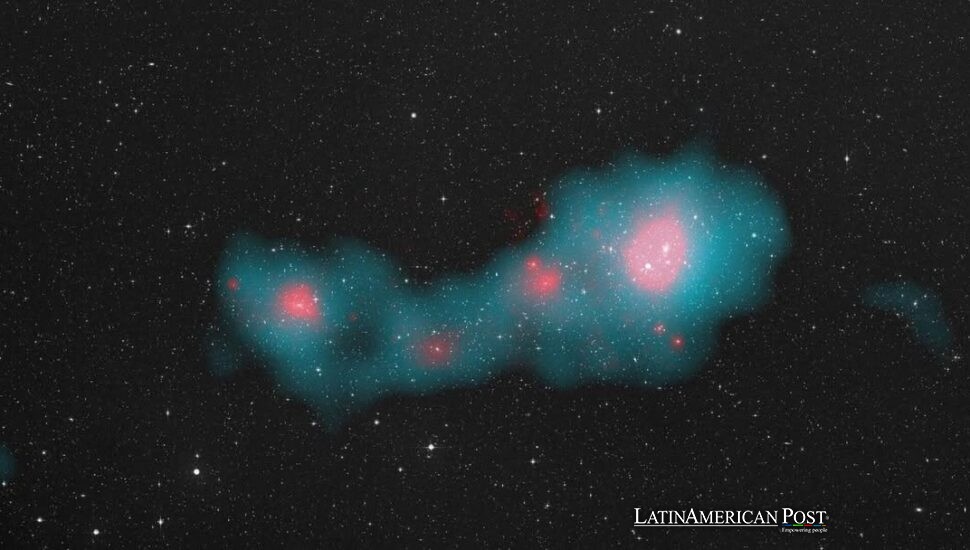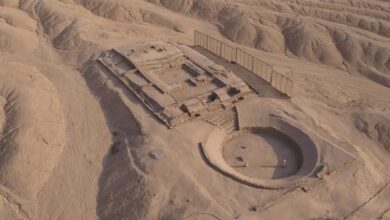Scientists Discovered the Largest Structure in Cosmos and Named it After Andean Ancient Artifact

A structure in space that people call “Quipu” came to light as a grouping that takes up a greater span than any other seen before. It spans 1.39 billion light years and sets off a change in our view of how the cosmos spreads and forms.
The Dazzling Revelation
Recently, astronomers uncovered a grand cosmic entity surpassing even the Sloan Great Wall in length—a mesmerizing 1.39 billion light-years from end to end. Dubbed “Quipu,” after the traditional knotted cords once used in the South American Andes for record-keeping, this new superstructure contains a mass equivalent to 200 quadrillion Suns. The impetus behind Quipu’s naming is not merely aesthetic. The structure fans out across space, with offshoots or “branches” reminiscent of cords, highlights how ancient Andean culture resonates with our cosmic explorations.
To place Quipu in context, imagine gazing out from our Solar System as a tiny vantage point within the Milky Way. Our galaxy is part of the Virgo Supercluster, a vast cluster arrangement that expands hundreds of millions of light-years. Until recently, astronomers believed one of the most significant known formations in the universe was the Sloan Great Wall, measuring about a billion light-years across. But Quipu, discovered via data from X-ray satellites and cluster surveys, outstretches the Sloan Great Wall, making it the most prominent local cosmic feature recognized.
The researchers behind this finding note how a small group of superstructures, including Quipu, collectively encompasses nearly half of all galaxy clusters in our vicinity. Their sheer scale defies our old assumptions that matter would be comparatively even in distribution. Quipu itself is no permanent fixture. According to the study, these structures are fleeting “transient” phenomena that will eventually break apart as the universe evolves. For now, Quipu’s huge size shows how space fits together with many parts; it tells us that matter groups into patterns covering long distances.
Reimagining the Universe’s Architecture
Understanding how Quipu fits into the cosmic tapestry demands a step back to see the bigger picture. Researchers have seen matter as forming a “cosmic web” of filaments for decades. Galaxies and clusters line up along these strands, with huge voids between them. On local scales, these filaments combine into what we might call “walls”—like the Sloan Great Wall or the Hercules-Corona Borealis Great Wall (the latter rumored to extend 10 billion light-years, although that remains contested).
Yet Quipu’s scale and composition upend many of our more straightforward concepts of how large superstructures arise. According to leading theories, the universe began roughly 13.8 billion years ago in the Big Bang, and gravity has gradually shaped matter into clumps: star systems, galaxies, clusters, and superclusters. The primary cosmological principle suggests that matter should be distributed somewhat uniformly when viewed at the largest scales. However, monstrous complexes like Quipu appear so vast that they might require longer than the universe’s age to form—posing a puzzle for astrophysics.
From an observational standpoint, the data used to characterize Quipu came from an X-ray satellite overseen by the German Aerospace Center, combined with a cluster catalog called CLASSIX. This trove helped researchers identify large swaths of matter by focusing on galaxy clusters. Clusters are among the most massive gravitationally bound objects in space—by tracing them, astronomers can glean how matter arranges into superstructures. The fact that Quipu alone dwarfs other known cosmic filaments suggests we must refine how we measure the distribution of galaxies. Despite the concept that filaments naturally coalesce in a cosmic web, an entity this large looks like an extreme testament to nature’s penchant for forging ephemeral mega-systems.
One critical implication is how these enormous arrangements influence phenomena like the cosmic microwave background (CMB). Mass on this scale creates a barely noticeable Sachs-Wolfe effect that changes the route and energy of CMB photons. Recent data shows an effect one sees, yet its impact stays small. This fact ties local superstructures to cosmological observations that form the accepted model of the universe’s development.
Quipu’s Cultural Echoes in the Andes
As remarkable as Quipu is for science, the name calls to mind the intricacy of ancient Andean knowledge systems, exceptionally the Quipu’s knotted threads used by pre-Columbian cultures for record-keeping. The name “Quipu” sounds suitable. Its design shows cords that stem from a central filament, much like the Andean Quipu, which uses a main cord with smaller threads coming off it. This comparison binds our past to a cosmic unveiling and forms a tie between the history of our land plus a vast, unfenced expanse overhead.
In a sense, we might see the naming as an homage to the advanced ways societies of the South American Andes documented census data or historical events. Even though modern astrophysics deals with X-ray satellites and advanced computations, connecting these discoveries to older traditions ground our cosmic findings in a shared sense of identity and continuity. A subtle lesson is embedded here: no matter how alien or grand a structure appears billions of light-years away, our interpretive lens always flows back to cultural references and stories we carry on Earth. Our species has always used metaphors from daily life to decode the perplexities of the heavens.
Yet ironically, this resonates with the larger conversation about free inquiry and imaginative naming that fosters curiosity. Just as ancient Andeans found ways to record knowledge through a humble device of knots and cords, modern cosmologists try to map the universe’s tapestry, bridging intangible gaps through linguistic or conceptual ties. The Quipu name is thus both an aesthetic flourish and a reflection of how scientific progress can engage with cultural memory without overshadowing it.
Embracing All Voices in the Cosmic Dialogue
We live in an era of extraordinary cosmic discoveries. The recognition of Quipu stands out as another leap forward, reminding us that each time we attempt to measure reality, we find that it extends further than we once thought possible. This process, which some call a “Copernican journey,” has taught us humility: Earth does not lie at the cosmic center, our galaxy, or even our local supercluster. Recent facts about vast systems such as Quipu call us to keep open minds and accept that space holds hidden arrangements with greater size or detail than those known. In a community that feels well, ideas from science reach public talk, thought, and imaginative revision. The idea is that no single authority can or should mandate how we talk about, name, or analyze cosmic phenomena. Everyone from astrophysicists to casual star-gazers can partake in that conversation. Similarly, society benefits when every viewpoint—enthusiastic or skeptical—gets a fair hearing. Indeed, robust inquiry thrives on the tension between competing voices, forging consensus only when evidence is clear.
This principle extends beyond just cosmic frontiers. On Earth, we sometimes see attempts to stifle certain forms of expression or knowledge for fear they might lead to confusion or overshadow official narratives. Yet, as the example of Quipu’s discovery shows, knowledge flourishes best when it is not forcibly compartmentalized. Whether from astronomy circles or local Andean communities, people can bring a perspective that spurs deeper insights and fosters wonder. That is the core advantage of open dialogue. Even in the face of a cosmic scale, individuals have a right to describe and interpret discoveries as they see fit.
If we limit the naming or spread of some cosmic facts or block the chance to publish them, we lose a way to add new details to the larger mix of cultural knowledge. The same principle applies to any social or philosophical domain: we risk self-inflicted blindness if we assume that uncomfortable or conflicting viewpoints must be shut out for the greater good. No matter how vast Quipu appears or how different the routes we take to set it forth, what matters most is how every view helps form our shared journey among the stars.
The find of Quipu, a structure that spans 1.39 billion light years, clearly shows our small place in a universe that grows every day. Its worth goes beyond any single number. Naming it after an Andean counting device ties advanced astronomy to cultural heritage in a manner that fosters free thought and imagination. We discover that while cosmic revelations show us the near-limitless frontiers overhead, they also circle us back to Earthly traditions and metaphors that anchor our knowledge in something deeply human.
Also Read: Brazil’s River Dolphins’ Strange Peeing on Their Head Mystery
In an environment where knowledge can be disputed, we should champion the necessity of free expression to interpret, debate, and share. No matter how massive or ephemeral Quipu ultimately proves to be—some scientists predict it might break apart—its legacy is a testament to our pursuit of answers. If cosmic evolution teaches us anything, change and reconfiguration are constants. So, too, the ways we talk about new cosmic marvels and the names we bestow upon them should remain open, thriving on curiosity and inclusive dialogues. By supporting free debate and resisting calls to censor or stifle discussion, we preserve the wonder that drew us to the stars in the first place.



